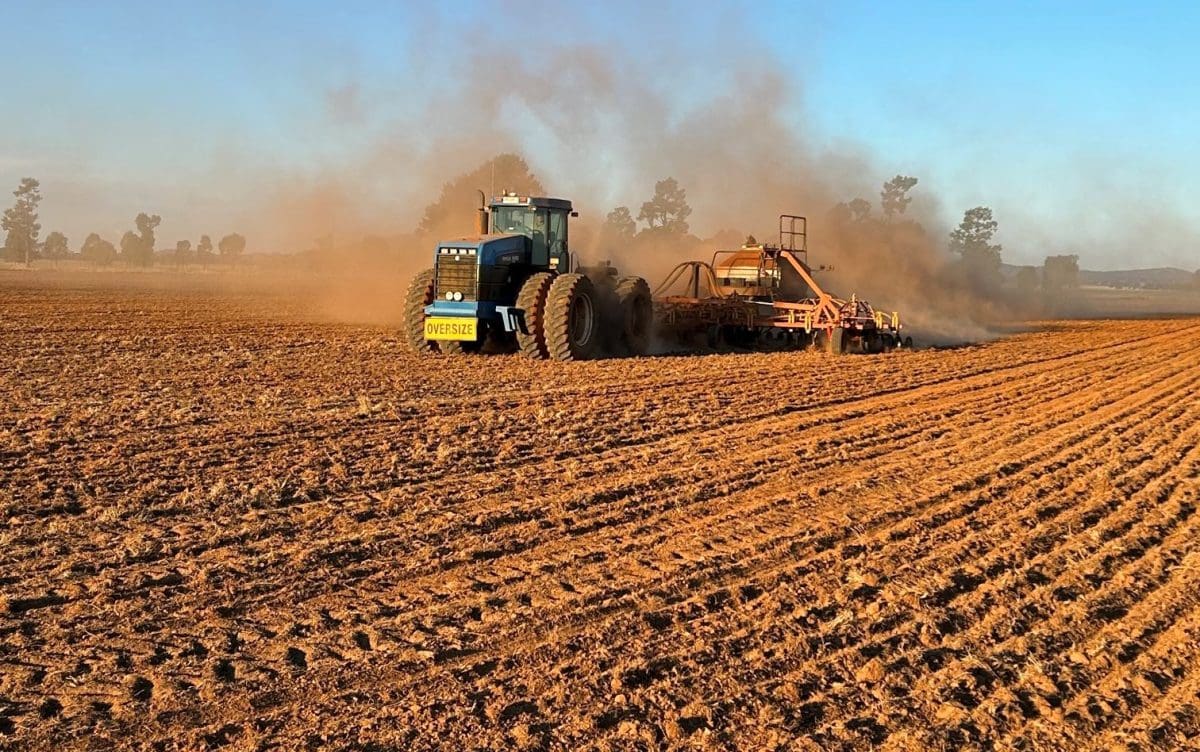
Blowing dust while planting wheat at Burcher in central NSW earlier this week. Photo: Adrian Blampied
FEED wheat and barley has traded sideways to firmer in the past week, with limited grower selling supporting values.
Deteriorating elevator margins for eastern Australian exporters show no sign of improving, particularly with news out overnight that the Black Sea grain corridor will remain open into July.
This has lifted volumes being offered from the trade, which is keen to push additional tonnage held up-country into the domestic market as the appeal of bulk export wanes.
Supporting Australia’s domestic market is dryness in some districts, where planting progress has slowed as growers wait for 10-20mm to wet topsoil and germinate dry-sown crops amid indications an El Niño may develop in coming months.
| Today | May 11 | |
| Barley Downs | $435 | $435 |
| SFW wheat Downs | $410 | $405 |
| Sorghum Downs | $375 | $380 |
| Barley Melbourne | $350 | $357 |
| ASW Melbourne | $400 | $392 |
| SFW Melbourne | $395 | $385 |
Table 1: Indicative prices in Australian dollars per tonne.
North gets welcome rain
Planting of winter crops is continuing at pace in the northern region, with most growers in northern New South Wales finished on canola and well into wheat.
Handy rain on Sunday and Monday, mostly north of the Qld-NSW border, has been ideally timed to wet the topsoil and maintain momentum on sowing.
In the week to 9am today, registrations in NSW include: Coonamble 15mm; Moree and Walgett 10mm.
Qld had the best of the grainbelt falls, including: Dalby 47mm; Felton 58mm; Macalister 38mm; Jondaryan 49mm; Roma 20mm; Surat 32mm.
The northern barley market has maintained its strength to reflect unfailing demand from the feedlot sector on barley.
“Barley has turned into quite an inelastic good because it’s feeding long-fed cattle,” one trader said.
“Cattle on feed for 400-450 days are a high-performing and high-marbling animal, and if the feedlots don’t get the performance in the meat, feeding those cattle is a wasted exercise.
“The takeaway from feedlots is those guys doing long-fed are committed to barley; the short-fed guys aren’t committed at all.”
With feeder cattle prices weakening in recent months, demand from feedlots on short-fed programs for SFW-type wheat is high, with poultry and pig demand adding further significant volume.
“The world outlook does impact Aussie prices, but the big drivers on the Downs are going to be the weather, new-crop planting, and liquidity.
“Growers are pretty cash rich at present, and they’re not a forced seller.”
With domestic flour millers and exporters well and truly covered into new crop on higher-spec wheat, trade sources say APW, ASW, SFW and even downgraded durum are trading at similar levels into the domestic feed market.
Wheat accumulated by traders with an eye to export is supplementing volume in the up-country market, which now appears more attractive because elevator margins have turned into negative territory, and show no sign of bouncing back into the positive
Sorghum is under considerable pressure as the southern Qld-northern NSW harvest wraps up, and bids out of China drop.
Growers and traders are hopeful the sorghum market will firm ahead of the start in earnest next month of the Central Queensland harvest, which is penciled in to produce 300,000t.
Southern
In South Australia, Australian Grain Exports trader Tyson Hewett said most growers were getting towards the end of their seeding program.
“They’re on the edge of their seat now with the forecast, and it would be nice for them to get some rain to get what’s going in in a dry seedbed out of the ground,” Mr Hewett said.
Mr Hewett said reasonable volumes of wheat and barley were being sold into the market, despite barley in particular being well supplied from other origins into the export market.
“It’s slowed down people wanting to get grain out of the east coast, and the market here is tapering exports.”
Mr Hewett said elevator margins on cereals have “narrowed to negative”, even in SA.
“That typically happens at this time of year, and growers want $40-$50/t more than what they’re being offered now.”
Talk of an El Niño developing in coming months has growers ever hopeful of a price rally, and in no hurry to sell following big sales programs in previous months.
In the Victorian Wimmera, Farm Trade Australia director David Matthews said growers have been fully focused on planting.
“Vic is 60-90pc planted now after a solid 3-4 weeks, and the early crops are up and looking good.
“Everyone is now looking westward and upward for 15-20mm to go on top of good subsoil moisture.”
Mr Matthews said cold mornings and clear days are adding to concerns about an El Niño developing.
“There’s dust behind seeders in parts of western Victoria.”

HAVE YOUR SAY